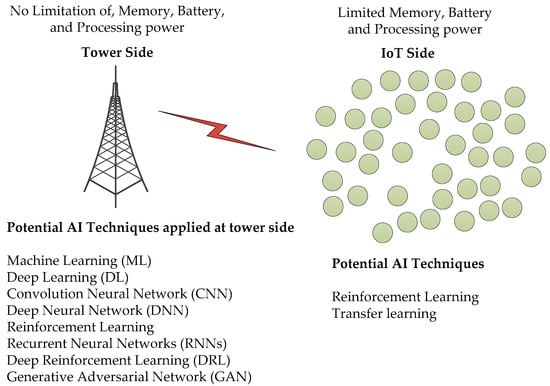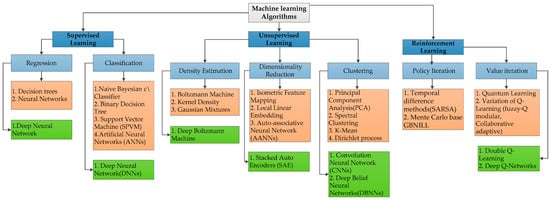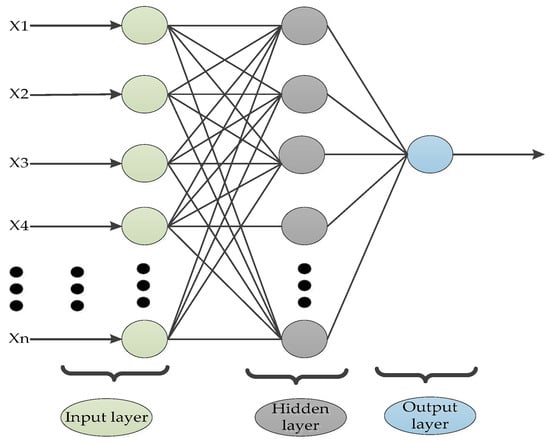The Internet of Things (IoT) and wireless sensor networks (WSNs) have evolved rapidly due to technological breakthroughs. WSNs generate high traffic due to the growing number of sensor nodes. Congestion is one of several problems caused by the huge amount of data in WSNs. When wireless network resources are limited and IoT devices require more and more resources, congestion occurs in extremely dense WSN-based IoT networks. Reduced throughput, reduced network capacity, and reduced energy efficiency within WSNs are all effects of congestion. These consequences eventually lead to network outages due to underutilized network resources, increased network operating costs, and significantly degraded quality of service (QoS).
- WSNs
- congestion mitigation
- artificial intelligence
- game theory
- IoT
1. Introduction
2. Why Use an Artificial Intelligence-Assisted Solution?
The development of artificial intelligence is often considered essential to the development of engineering and technology. In the wireless communication network of the near future based on the Internet of Things, artificial intelligence will play an essential role in meeting the requirements of the communication system. Smart infrastructures, including smart grids, smart homes, smart cities, smart meters, and a globally interconnected smart grid, will proliferate in the coming era. Internet of Everything (IoE) communications technology will be used to make the concept of a smart world a reality. To realize a smart society, a wireless network based on the IoE must also be built. It is critical to make communication systems and other key components intelligent to improve their functionality. It is crucial to find an artificial intelligence (AI)-based solution to meet the future needs of a technologically advanced and environmentally friendly society [13][19]. The list of Nomenclature is shown in Table 1.|
Acronyms |
Definition |
|---|
3.1. Previous Work on WSN Congestion Mitigation Schemes
Previous work in the domain of WSN congestion mitigation can be divided into four main categories, as shown in Figure 1.
4. Scope of AI-Based Solutions in WSNs

Significance of Proposed Work in Smart and Green World
5. Potential Future Emerging AI-Based Solutions for Congestion Mitigation in Ultra-Dense WSNs
Machine Learning (ML) for WSNs
|
Algo. |
Ref. |
Solution Technique |
Packet Loss Type |
Limitation |
||||||||||||
|---|---|---|---|---|---|---|---|---|---|---|---|---|---|---|---|---|
|
Traffic Control |
Resource Control |
6LoWPAN |
WSN |
Buffer Loss |
Channel Loss |
|||||||||||
|
Back pressure |
X |
✓ |
X ✓ |
✓ |
X |
✓ ✓ |
X |
|||||||||
|
IP |
||||||||||||||||
Simulation not verified in real WSN simulators like cooja |
Internet Protocol |
|||||||||||||||
Role of LTE-A in Emerging Machine Type Category (CAT-M) and Narrowband IoT Category (CAT-N). |
[ | |||||||||||||||
|
GTCCF |
[28 Survey |
] 2017 |
[38] |
✓ Up-to-date and comprehensive survey on (CAT-M) and (CAT-N). |
X |
✓ ✓ |
X ✓ |
✓ X |
X |
6LoWPAN |
||||||
High energy consumption, low throughput |
Machine learning applications in the IoT domain |
IPv6 over Low-Power Wireless Personal Area Network |
||||||||||||||
|
OHCA |
Survey |
✓ 2018 |
Comprehensive Survey on ML techniques and applications in IoT |
✓ X |
✓ |
X ✓ |
||||||||||
✓ | X | High energy consumption, low throughput |
QoS |
Routing Protocol low-power and lossy networks (RPL) by contiki operating system (OS) |
||||||||||||
|
NCGEE |
Quality of Service |
|||||||||||||||
Survey |
2018 |
First Survey that categories RPL via contiki OS |
✓ |
✓ |
X |
|||||||||||
✓ |
✓ |
✓ |
X |
✓ |
✓ |
- |
I-IOT |
Intelligent Internet of Things |
||||||||
|
Deep Transfer Learning |
[ | |||||||||||||||
|
Game Theory |
Survey |
] 2018 |
[ Review latest work on transfer learning via DNNs as well as their application. |
✓ X |
] |
X X |
✓ |
X✓ |
✓ |
X |
- |
RACH |
||||
|
Application Deep reinforcement learning (DRL) in IoT and UAV |
Random Access Channel |
|||||||||||||||
|
Survey |
||||||||||||||||
|
DCCC6 | 2019 |
X |
✓ Review on Deep reinforcement learning in network different prospects. |
✓ X |
X ✓ |
✓ ✓ |
X |
- |
ROC |
|||||||
|
WSN recourses allocation by DL and ML. |
Receiver Operating characteristic |
|||||||||||||||
|
GTCC |
Survey |
], 2020 |
This work comprehends the DL and ML based techniques for resource allocation in WSN in Heterogeneous Networks (HetNets), NOMA, D2D communication prospective. |
X |
✓ ✓ |
✓ |
X |
✓ |
X |
✓ |
X |
- |
SGNANs | |||
[ |
Various congestion mitigation algorithms are reviewed. |
Smart Grid Neighborhood Area Networks |
||||||||||||||
[23 | ||||||||||||||||
|
RPL | ][29] |
Survey |
✓ 2020 |
X This review is based on different techniques to control congestion as well a novel taxonomy has been proposed. |
✓ ✓ |
X X |
✓✓ |
SoNCF | ||||||||
X | - |
Transfer Learning | ||||||||||||||
|
This work |
Self-organizing network coordination framework |
|||||||||||||||
|
- Survey |
✓ 2021 |
✓Transfer learning and different machine learning techniques relationships. |
X |
✓ |
✓ ✓ |
✓ X |
✓ |
TCP/IP | ||||||||
, |
Congestion mitigation AI algorithms in nature |
Transmission Control Protocol IP |
||||||||||||||
- |
Survey |
2023 |
Reviewed AI algorithms exist in nature. |
✓ |
X |
✓ |
TARA |
Topology Aware Resource Adaptation (TARA) |
||||||||
|
AI based algorithms review to solve congestion in WSN. |
This work |
Survey |
2023 |
The novel review on congestion mitigation based on AI based solution in WSN. |
✓ |
✓ |
LTE-A |
Long-Term Evolution-Advanced |
||||||||
|
LSTM |
Long Short-Term Memory |
|||||||||||||||
|
ML |
Machine Learning |
|||||||||||||||
|
M2M |
Machine to Machine |
|||||||||||||||
✓ |
MAC |
Media Access Control |
||||||||||||||
|
CAT-M |
Machine type category |
|||||||||||||||
|
mMTC |
Massive Machine Type Communication |
|||||||||||||||
|
MADM |
Multi-Attribute Decision Making |
|||||||||||||||
|
CAT-N |
Narrowband IoT Category |
|||||||||||||||
|
OS |
Operating system |
Optimization-based Hybrid Congestion Alleviation |
||||||||||||||
✓ | ||||||||||||||||
|
OHCA |
PB-ALOHA |
Pseudo Bayesian ALOHA |
||||||||||||||
|
PRA |
Prioritized Random Access |
|||||||||||||||
|
PSO |
Particle Swarm Optimization |
|||||||||||||||
|
RPL |
Routing Protocol low-power and lossy networks |
|||||||||||||||
|
SOSUS |
Sound Surveillance System |
|||||||||||||||
|
SDN-IoT |
Software-Defined Networking based on IoT |
|||||||||||||||
|
SDRs |
Software-Defined Routers |
|||||||||||||||
|
TR |
Technical Report |
|||||||||||||||
|
UDP |
User Datagram Protocol |
|||||||||||||||
|
USA |
United States of America |
|||||||||||||||
|
WSNs |
Wireless Sensor Networks |
|||||||||||||||
Why Use an ML-Based Congestion Mitigation Solution for WSNs?
A subfield of artificial intelligence (AI) called machine learning (ML) is concerned with using machine learning algorithms to help computers acquire new information and skills. These algorithms make it easier for a computer to evolve into an intelligent being. ThWe researchers will explore the many types of machine learning and their associated algorithms in later sections. It is predicted that advanced systems will emerge in the near future that have the ability to self-heal, be highly dynamic, and be self-preserving. In thesae systems, machine learning is of critical importance. Future wireless networks will be intelligent enoaugh to meet the above requirements, with DL and ML algorithms playing a crucial role [13][14][19,20]. It is expected that resource management in the extremely dense IoT network will be significantly affected by deep learning (DL) and machine learning (ML) [15][21]. A comparison of the contributions made by researchers in the field of IoT network congestion mitigation is shown in Table 2. The utilization of deep neural networks (DNNs) in WSN devices facilitates the capability of these IoT devices to perform intricate sensing tasks and foster collaboration between the environment and humans [16][22].3. Congestion Mitigation Algorithms for WSNs
6. Fundamentals of ML and Taxonomy of Applications

7. Learning Capabilities and Requirements
8. Artificial Neural Networks (ANNs) for Congestion Mitigation of WSNs
8.1. DL for Congestion Mitigation of Wireless-Based IoT Networks
A branch of ML is called DL. The deep layer of the neural network is where the input data are propagated to create the intelligent system [38][109]. To compute the output, the deep layers perform many different mathematical operations, including thresholding/limitation and combination [39][110]. A system based on DL automatically learns to map or model the already accessible data sets through significant feature extraction, either through unsupervised or/and supervised learning approaches [40][111]. In [41][112], the application of the DNN technique in wireless network-based communication was studied. The applications of DL are strongly encouraged for use in the upcoming wireless communication networks [42][113]. DL offers tremendous promise for wireless communications and for reducing congestion in WSNs that manage, deploy, schedule, maintain, and control resources (radio, channels, energy), among others [43][114]. DL in [44][115] and [45][94] was proposed as an optimization approach for downlink beamforming. The above proposal needs to be studied in the context of reducing congestion in WSN networks, as it could provide excellent results. These also offer tremendous potential for IoT congestion in the areas of data loading and caching, traffic routing, power control, resource sharing, traffic routing, dynamic spectrum access, etc. The authors of [46][116] give an overview of various DL applications in wireless networks. In [47][100], dynamic/intelligent allocation of radio resources was highlighted in a survey of wireless communication networks at the physical layer. In [48][117], a plan for channel characteristics for BSs with multiple antennas was presented. With only a few adjustments, this method can be used to reduce congestion in IoT networks. Due to the growth of IoT communications in the near future, ANNs have significant potential for estimation, job preservation, control, scheduling, tracking, and optimization to reduce congestion in wireless IoT networks. ANNs are important enablers in the deep learning process, as shown in Figure 4 [41][112]. Important aspects of data from DL as well as distribution have been learned automatically.
